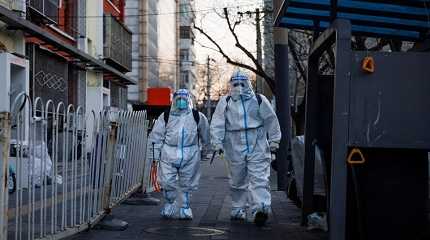
HONG KONG/BEIJING, Dec 5 (Reuters) - China is set to announce a further easing of some of the world's toughest COVID curbs as early as Wednesday, sources said, as investors cheered the prospect of a policy shift that follows widespread protests and mounting economic damage.
Three years into the pandemic, China's zero-tolerance measures, from shut borders to frequent lockdowns, contrast sharply with the rest of the world, which has largely decided to live with the virus.
The strict approach has battered the world's second-largest economy, put mental strain on hundreds of millions and last month prompted the biggest show of public discontent in mainland China since President Xi Jinping took power in 2012.
Although last month's protests largely subsided amid a heavy police presence across major cities, regional authorities have since cut back on lockdowns, quarantine rules and testing requirements to varying degrees. Top officials have also softened their tone on the dangers posed by the virus.
The financial hub of Shanghai announced on Monday night that it would remove COVID testing requirements for people to enter most public places from Tuesday.
And a new set of nationwide rules is due to be announced soon, two sources with knowledge of the matter told Reuters, paving the way for more coordinated easing.
Beijing is also weighing whether to scale down its management of the virus to reflect the less serious threat it poses as early as January, the sources added.
The yuan jumped to its strongest level against the dollar since mid-September amid a broad market rally as investors hope the unwinding of pandemic curbs will brighten the outlook for global growth.
In another hopeful sign, a source at Apple supplier Foxconn (2317.TW) told Reuters the firm expected its COVID-hit Zhengzhou plant - the world's biggest iPhone factory - to resume full production this month or early next.
Economic data underscored the damage done by the curbs, as services activity shrank to six-month lows in November.
CHANGING MESSAGE
Alongside the easing in different cities, Vice Premier Sun Chunlan, who oversees China's COVID efforts, said last week the ability of the virus to cause disease was weakening.
That change in messaging aligns with the position held by many health officials around the world for more than a year.
In recent days, major cities across China have continued loosening measures.
Among them, the eastern city of Nanjing dropped the need of a COVID test to use public transport. So did Beijing, though entry to many offices in the capital still requires negative tests.
"I can't feel a very noticeable change yet," said Randle Li, 25, a marketing professional in Beijing. Li said his firm still required him to test every day to enter the office.
Elsewhere, as testing requirements have eased, official figures of new infections have also dropped.
Hu Xijin, a prominent commentator and former editor-in-chief of state-run tabloid Global Times, said in a blog that some official tallies were likely underreporting the spread of the virus because of lower testing rates.
While the protests have died down, frustration can still boil over, as events in the central city of Wuhan, where the virus first emerged in late 2019, showed this weekend.
On Saturday, people pushed down barriers in an apparent attempt to break out of a lockdown at a garment industrial park, video clips posted on Twitter showed.
Then on Sunday, dozens of students stood in the rain outside a university in the city demanding greater "transparency" in COVID policies, other videos showed.
Reuters was able to verify that the incidents happened in Wuhan.




